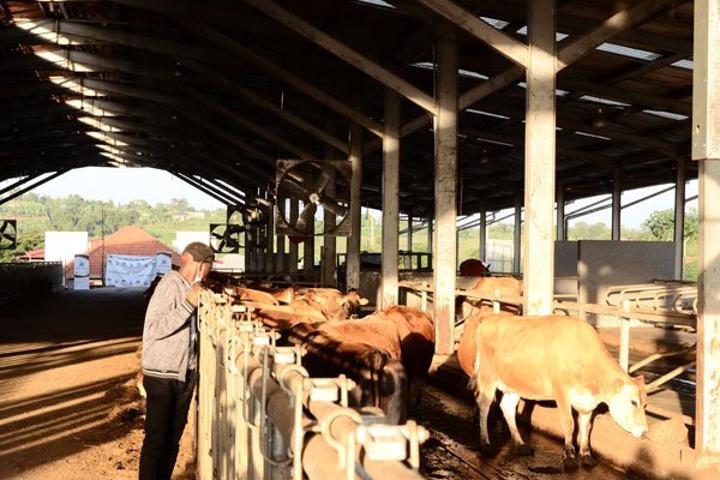Africa-Press – Uganda. The impact of heat stress on dairy cows during hot months has been found to have a significant drop in milk production.According to scientists at the National Livestock Resources Research Institute (NaLIRRI) in Nakyesasa, high temperatures and humidity must be controlled.
Just like top athletes, cows work best under ideal conditions. Dairy cows and calves prefer a temperature range from 4 to 17°C. Starting at a temperature of 20°C, a relative humidity of 70 per cent and insufficient ventilation inside the shed, cows begin experiencing stress due to excessive heat.Dr Moses Dhikusooka, a livestock expert, says lactating cows are affected greatly by heat stress.
Cool cows
Dr Dhikusooka says this could be reduced through the provision of shade and more water troughs. But the simplest method, Dr Dhikusooka says, can be through the installation of fans in the cattle shed.“Whenever the ambient temperature is above 32 degrees, most of the cows are seeking shade while others are waiting for the opportunity to drink,” Dr Dhikusooka says.
He explains that very hot and humid conditions lead to a significant drop in milk production as most cows stop grazing, seek shade, pant and spendmore time at watering points to counteract the heat.“Environmental heat stresses milking cows a lot as well as the metabolic heat produced by the cow itself to support bodily functions,” he says.According to Dr Dhikusooka, cows sweat faster than humans. So, what one may perceive as a pleasant interior temperature, already feels uncomfortable for livestock. By comparison: A human takes an average of 17 breaths per minute, a stressed cow up takes up to 80 breaths.
Dr Dhikusooka explains that lactating dairy cattle tend to be more sensitive to heat stress because of their increased metabolic heat production, which is a result of their higher feeding requirements to support high milk yield.In order to balance the heat in animals that are not heat tolerant, farmers must take actions to improve livestock welfare such as the provision of shade to protect cows from solar radiation and water for the cows to cool down.
“Physical modification of the environment is necessary by providing shade for the cattle, fans and sprinklers to cool down,” Dr Dhikusooka said.According to Dr Dhikusooka, ventilation is a major priority in infrastructure planning for effective air movement. But fans help increase this by helping move warm air away from the cow while creating air movement over the cow’s skin to enhance evaporative cooling through sweating.
Valuable
Fans are important in controlling harmful ammonia gas in the shed. Ammonia gas is created if manure and urine are decomposed by bacteria. The gas is acidic as it affects horns and hooves.Fans can be supplemented by fans, according to Dr Dhikusooka.
Fans are also helpful in expelling flies and flying insects due to the constant air circulation.He explains that there are technical specifications concerning appliances and their installation. “For example, the fans near sleeping and feeding areas should cool without drying out the food,” he says.There are specific types of fans that can be used in farming environments including; ceiling fan, TDA ceiling fan, wall-mounted fan, inline fan, axial-flow fan, high performance extractor fan, oscillating fan and reversible fan.“But these depend on the size of the shed and the money available,” he says.
Caution
Dr Dhikusooka says floor fans are not suitable because they raise dust adding that a farmer using a fan should add a controller to adjust the fan’s settings.The positioning of the fans largely depends on the construction of the shed, height of the ceiling, length and width of the building. Ceiling fans, for instance, should have a minimum distance of 2.7 metres to the ground.The noise of the fans, according to Dr Dhikusooka, should be as low as possible, particularly during the resting periods to prevent additional stress.
Takeaways
ConsiderationsKeep the safety grill around each fan free of cobwebs and dust to maintain their maximum efficiency and effectiveness.
Symptoms for stress in livestock.Damp to wet furIntensified breathingLazy behaviourReduced food intakeIncreased need for liquidsAnimals seek refuge in the shed






